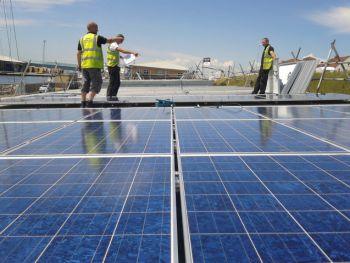Brighton & Hove: where do they get their energy from?
By: Patrick Reed
Last updated: Wednesday, 11 July 2018

Brighton Energy Co-op have set up community renewable energy projects, including installing solar panels to create electricity.

Building the Rampion offshore wind farm (Image by peganum, CC.2.0 Licence)
An event at the British Airways i360 this Wednesday 20 June will be using the story of Brighton’s energy past, present and future to map out global energy innovations.
The Science Policy Research Unit (SPRU) at the University of Sussex are bringing together local energy innovators from Rampion Offshore Wind, Brighton Energy Cooperative and Brighton & Hove Energy Services Cooperative (BHESCO) with international policymakers and researchers from across the globe, to discuss how cities can tackle increased energy demand in future.
Brighton & Hove has one of the world’s longest uninterrupted electricity supply anywhere in the world, with first electricity company founded in the city by Robert Hammond in 1882. The Volks Railway, Britain’s first electric railway, was opened by the mayor of Brighton the following year.
A ‘flight’ on the i360 will provide an aerial 360-degree showcase of Brighton and Hove's historic and contemporary energy system, and will be followed by a panel discussion with local innovators from Rampion Offshore Wind, Brighton Energy Cooperative and Brighton & Hove Energy Services Cooperative (BHESCO), who will introduce and discuss their contributions to the city's energy demands.
The two groups will also be joined by Dr Ralitsa Hiteva, who will bridge the gap between policy and practice through her own research in infrastructure governance and regulation, and the discussion will be chaired by Professor Gordon Mackerron, (former Director of SPRU and The Sussex Energy Group).
As debates rage over whether cities should expand renewable energy sources or tap up regional oil and gas resources, the forum offers policymakers a unique opportunity to look at how Brighton has grown its energy resource base through innovative policy decisions.
Brighton & Hove has started to source more of its electricity from renewable resources such as the Rampion Wind Farm, which will supply the equivalent of 350,000 homes and could avoid the emission of almost 600,000 tonnes CO2 per year being released into the atmosphere each year.
Grassroots energy initiatives also have a major impact in this city. Thousands of buildings and households across the city (including Council-owned social housing) have installed solar photovoltaic panels, many with support from Brighton Energy Cooperative and Brighton & Hove Energy Services Cooperative (BHESCO).
The event forms part of a five-day professional development course, hosted by SPRU at the University of Sussex, focusing on innovation policies in relation to the dramatic social, technological, environmental and geopolitical shifts we see around the world today.
Professor Johan Schot, Director of SPRU, said:
“SPRU has an excellent reputation worldwide for being at the forefront of research on science, technology and innovation policy. SPRU training initiatives are a great opportunity for this research to achieve real impact by bringing this valuable work to international policy audiences.
“These courses, with the guidance and support of our expert faculty, equip policy professionals to translate cutting-edge research into practical policies.”
Click here for more information on training courses and further study with SPRU.

